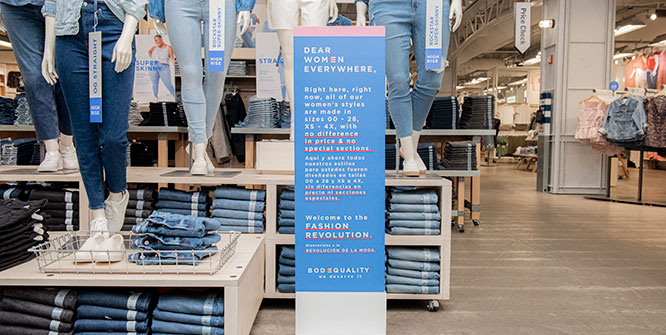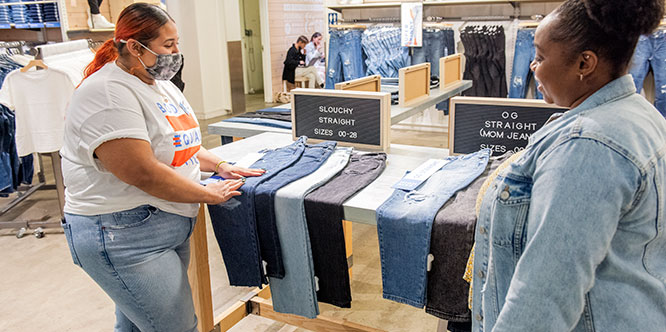
Photo: Old Navy
May 23, 2022
Can Old Navy plot a new course and keep its inclusivity pledge?
Old Navy, last August, made a promise to women that it would offer all the items in its line in sizes 0 to 30 and XS to 4X and that it would not charge more for larger sizes.
The retailer’s pledge of inclusivity was laudable. The executional reality, however, is that Old Navy’s sales performance suffered as it wound up with too much inventory for extra small and large sizes and not enough for customers in between.
Old Navy’s BODEQUALITY initiative didn’t just mean that the chain would expand its size selection. It did away with separate spaces for petite and plus sizes and integrated all size items of the same merchandise together. Mannequins in stores were displayed to represent merchandise in sizes four, 12 and 18.
Alison Partridge Stickney, global VP women’s + maternity at Old Navy, at the time of the program’s launch, said, “We set out to understand what women of all sizes wanted from fashion and the shopping experience and were inspired to revolutionize every area of our business — from how we fit and design our products, to how we communicate to customers in stores and online — to ensure that all women feel welcome and represented. This launch is a transformative moment for our brand and the fashion industry.”

The program did transform Old Navy’s business in some ways, but clearly not for the better as a Wall Street Journal article points out. The chain’s sales fell off almost straight following the rollout and Old Navy CEO Nancy Green stepped down after fewer than two years on the job.
Gap Inc., the parent company of Old Navy, will report its latest quarter’s results on May 26. The retail chain operator last month lowered its expectations for the chain with a decline in revenues between the low to mid-teens. Margins are also expected to be impacted as the chain has had to increase promotions to generate traffic and move excess inventory.
Paul Lejuez, a Citi analyst, told the Journal that Old Navy’s BODEQUALITY initiative has failed to attract enough new customers to the chain’s store and site, nor are existing customers buying more merchandise.
Consumers may say they like Old Navy’s message of inclusivity, but that isn’t enough.
“If some of those sizes don’t sell, it doesn’t make sense to use up the floor space,” said Mr. Lejuez.
- Has Old Navy charted a course for all retail to follow on plus-sizes? – RetailWire
- Old Navy Democratizes the Shopping Experience for Women of All Sizes with BODEQUALITY – Gap Inc.
- Old Navy Made Clothing Sizes for Everyone. It Backfired. – The Wall Street Journal
- Are Old Navy’s issues more about demand than supply? – RetailWire
- Why hasn’t plus-sized apparel been an easy win for retail? – RetailWire
Discussion Questions
DISCUSSION QUESTIONS: What do you think has gone wrong with Old Navy’s BODEQUALITY program? Should the chain abandon ship or try to steer a new course for its inclusivity approach?
Poll
BrainTrust
Carol Spieckerman
President, Spieckerman Retail
Paula Rosenblum
Co-founder, RSR Research
Liza Amlani
Principal and Founder, Retail Strategy Group
Recent Discussions







Anecdotally, my wife had a hard time finding her size (she’s like XS) in the styles she liked – not because it wasn’t there, but because she had to wade through so many items to find it. She has a problem finding things – she’s not having a good time shopping at Old Navy. It was a nice woke idea, maybe not so much of a nice financial idea.
Old Navy should be using distribution data widely available about where women fall on the size continuum to better plan for popular sizes, but if the merchandise isn’t great, then it’s not going to sell. Perhaps that’s the root problem?
I have a hard time believing that the BODEQUALITY program is singularly responsible for Old Navy’s woes. The disappointing profitability posted by Walmart and Target attests to the challenges retailers are weathering, especially in discretionary categories. Even so, it’s difficult to run a program like BODEQUALITY profitably for a value retailer like Old Navy. The emphasis has been on highlighting bigger sizes, which do cost more to make, yet Old Navy also offers small and petite sizes. Representing a full range of sizes takes up a lot of room and adds complexity to an already-stressed supply chain. Given the lackluster response to the program, Old Navy might get away with making modifications.
For years, department stores have isolated petites and women’s sizes to make them easier to find. Why not Old Navy?
Because it’s not inclusive? That was exactly what my wife Toni said!
Turns out the decision to be inclusive is complicated and difficult to execute. There’s fit — garment specs by size. There’s breadth and depth — how many sizes to include and at what depth. There’s floor capacity — how does existing content and presentation have to change to make room for new offerings? And finally there’s design. Is it as simple as offering existing designs in the extended sizes, or do extended sizes need some kind of modified attitude and aesthetic? So it might not be because the retailer or brand is being exclusionary. It just might be because it’s damned complicated and difficult.
Damn difficult indeed and the new traffic they seek to acquire may not like their styles, fabric or wearability.
This is spot on.
The only way this will work is that each store has to be tailored to the sizing of its demographic – period. This means that they will have to really rationalize their assortment by store, by size. It is a huge time and financial investment, and while I see what they are doing as positive, it is very hard to execute at the operations level and there needs to be a way to make it manageable on an everyday basis.
Old Navy has been in rough waters for some time, long before BODEQUALITY. Adding inventory and making the store harder to shop wasn’t the way to execute what might have been a great idea.
Old Navy’s BODEQUALITY is revolutionary. Nowhere, other than QVC and HSN can women find every size in one place, with every item at the same price. Petite or plus-size, how wonderful it is not to be told your size is housed in a tiny department on another floor.
The whole “we were left with too many extra extra small and too many extra extra large items” concern is a buying issue that every apparel retailer has to dance with. When I visit chain stores that sell only misses sizes often the only sizes left are extra and extra extra small. Perhaps the size spread is too extreme or offering the smallest and largest sizes online only is a fix. Whatever the solution, I think it’s important that Old Navy figures it out.
Size inclusivity is not a campaign or an initiative; it’s a long-term brand decision that should be built into Gap’s merchandise plan through a holistic narrative. If not them, then who? Many brands have seen success with full-price, core replenishment programs to create consistency, maintain margins, control inventory levels and focus on targeted acquisition. They are well positioned in their market to become a destination for women of all sizes, but it’s going to take time to reintroduce the brand to customers that were previously left underserved. Meaningful initiatives take a significant amount of time to trickle down to general consumers. You can’t measure success based on how many people run to the store after seeing a commercial on TV or an Instagram ad. Now is the time to build out three-to-five year incremental growth plans and gain that additional marketshare.
Old Navy’s stance on inclusivity with their BODEQUALITY initiative is truly commendable. However the merchandising selection and execution must be aligned with the changing consumer preferences and centered around the customer journey. The goal should be to make the in-store experience as seamless as possible so all sizes are easily found, and the store is easy to navigate.
There are clear macroeconomic factors at play, including inflation, rising costs, conservative spending habits, rising fuel costs, and other concerns that have influenced consumers to be more conscious of their spending habits. Perhaps it will take more time for this initiative to take off.
This is what makes apparel so different from other categories – managing size runs in product assortments by store. The inventory requirements are extremely difficult to manage. Without visibility into their inventory, we don’t know how it was balanced by size or how the markdowns occurred at the store/SKU level. This is important data for Old Navy to guide their changes to their strategy if they they plan to keep this going.
Some approaches I’ve taken in my past life to address this sort of issue:
There’s a lot to talk about on this issue. I do commend Old Navy and Gap for taking this on and for holding steady on pricing for all their customers, I sincerely hope they figure this out and become successful in this endeavor so more retailers become inspired to do the same.
Old Navy needs to give the Bodequality strategy a chance. It takes time to capture data to truly understand which sizes should be allocated to the stores and where customers will shop a particular size. Leveraging the data is critical. This is an inventory management and planning issue. The Bodequality strategy should continue its course.
The nuances of traditional product development and planning processes are very limiting and capturing the right depth and size scales is something many brands can’t do, let alone execute at scale like Old Navy.
While speaking to Suzanne for this WSJ article, I stressed the importance in understanding how planning teams are limited to size runs and size scales today. It costs more (as DVF pointed out) and initially, extending sizes will show a loss until we know what actually sells at what size and predict what the customer is going to buy. Until we push teams like sourcing/costing, factories, product development, planning and even fit to think differently, it will be a painful process to expand size ranges. But this work needs to be done. We can’t keep planning the same 2-14 size runs as this doesn’t represent the customer.
It probably wasn’t the best time to start a new line of business. While there are people who may have returned to stores, it’s hard to visualize trying out a new one during the pandemic. How does the sizing work? Styling?
All this requires trips to the fitting room or massive returns. COVID-19 fears remain strong among those with “co-morbidities.” I might’ve waited and started with marketing first. “Coming soon…” Something like that.
Competing against Old Navy for many years while at AEO, we never considered their place in the shopping consideration set as a threat except in the lower end of the price/value equation. T-shirts, hoodies and jeans are their bread and butter. Offering a wider selection of goods across the size spectrum here in the U.S. makes perfect sense if the fit, product quality, color and price are right. Placing all sizes “together” for any one particular item is the right move as you don’t want to push shoppers into different areas of the store based on size – not a good “look.” Inclusive sizes is the right move. The “I’m a dancer now” TV spot was perhaps not the best approach to introduce the new BODEQUALITY merchandising strategy.
Good deeds may not necessarily result in increased revenue. By tying sales to I&D goals, corporations convey to all stakeholders that they’re really interested in the moral desert rather than making a real social change.
Instead of doing good deeds just for the sake of doing them, retailers must first understand their customers and then redefine their ICPs. This will allow them to be linked with only those customers who support their inclusivity efforts and other values.